In Canadian homes, the most common plumbing pipe types include copper pipes, PEX plumbing, PVC pipes, and cast iron pipes—each with unique benefits and expected lifespans.
Copper pipes are durable and often last over 50 years. PEX plumbing is flexible and freeze-resistant, making it ideal for harsh winters. PVC pipes are lightweight and reliable for drains, while cast iron pipes are strong but prone to corrosion as they age.
Knowing which pipes run through your walls can help you spot warning signs early, plan upgrades wisely, and protect your home from leaks or frozen bursts. Let’s take a closer look at how to identify the pipes in your home, what they’re designed for, and how long you can expect them to last.
|
Mr. Rooter Plumbing® identifies the most common pipe materials in Canadian homes:
Not sure what you have? A local Mr. Rooter Plumbing professional can help identify and repair your pipes. |
How to Identify Plumbing Pipe Types in Your Home
The pipes in your home may look similar at first glance, but each material has distinct features. You can often identify the material with a quick check in the basement, under a sink, or near the water heater. Here are the most common types of plumbing pipes found in Canadian homes:
- Copper: A rigid, reddish-brown metal pipe that may show green or blue corrosion at the joints. Durable and long-lasting, with a lifespan of 50 years or more.
- PEX: Flexible plastic tubing, usually red, blue, or white. Common in newer builds and renovations since the 1990s; valued for its freeze resistance. PVC: White or light-grey rigid plastic, lightweight and hollow-sounding when tapped. Most often used for drain and vent lines.
- CPVC: A cream or off-white version of PVC that withstands hot water but is more brittle than PEX.
- Cast iron: Thick, heavy, dark-grey or black pipes, often found in older homes for drain or waste lines. Strong but prone to rust and scaling over time.
- Galvanized steel: Dull grey threaded metal pipes, common in homes built before the 1960s. These pipes often corrode from the inside, which can constrict water flow.
A plumbing professional can help verify the types of piping in your home. For a deeper dive, check out our comprehensive guide on the various types of plumbing pipes. If you suspect hidden damage, request water leak detection services to identify and address problems before they escalate.
Now that you know how to recognize different types of piping, let’s explore what each pipe is designed for, how long it lasts, and where it performs best in your home.
Common Plumbing Pipe Types Explained
Every pipe has a job to do: Some handle hot water, some stand up to freezing temperatures, and others are just better left in the past. Knowing the difference helps you make smarter choices for your home. For a closer look at how water arrives in your home, check out our guide to the best pipe materials for carrying water.
Copper pipes

Copper is one of the most reliable plumbing materials and has been used in homes for decades.
- Lifespan: 50+ years with proper maintenance.
- Strengths: Durable, safe for hot and cold water, resists bacteria.
- Limitations: Higher cost than plastic pipes; may corrode if water is highly acidic.
- Usage: Still a trusted choice in many homes, especially where longevity matters.
PEX plumbing
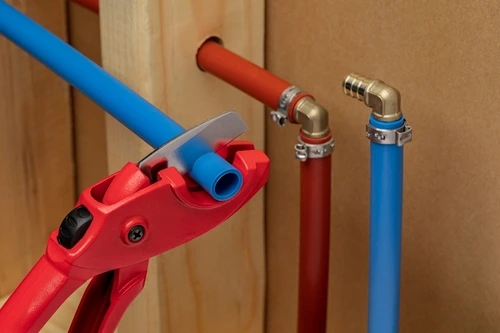
PEX (cross-linked polyethylene) is a flexible plastic tubing that’s become popular in newer builds and retrofits.
- Lifespan: 25–40 years.
- Strengths: Flexible, easy to install, freeze-resistant, ideal for retrofits.
- Limitations: Can degrade if exposed to UV light; not always accepted by every municipality.
- Usage: Favoured in colder climates because it resists bursting during freeze-thaw cycles.
PVC pipes
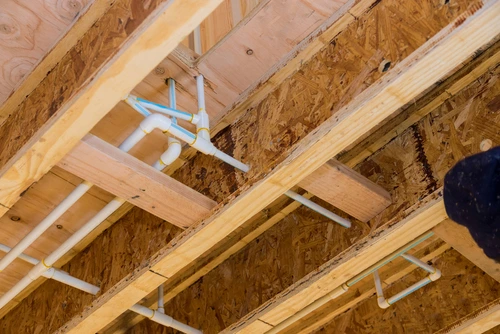
PVC (polyvinyl chloride) is a lightweight plastic commonly used for drain, waste, and vent systems.
- Lifespan: 25–40 years.
- Strengths: Lightweight, inexpensive, easy to install, corrosion-resistant.
- Limitations: Not suitable for hot water supply; can become brittle with age.
- Usage: Widely used in residential drainage systems due to affordability.
CPVC Pipes
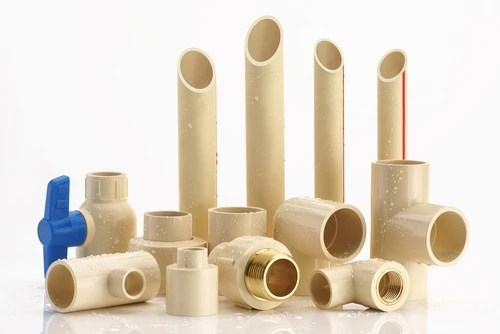
CPVC (chlorinated polyvinyl chloride) resembles PVC but can withstand higher temperatures.
- Lifespan: 40–50 years.
- Strengths: Safe for hot water lines, affordable, corrosion-resistant.
- Limitations: More brittle than PEX; prone to cracking if stressed.
- Usage: A cost-effective, hot-water-safe alternative to copper.
Cast Iron Pipes
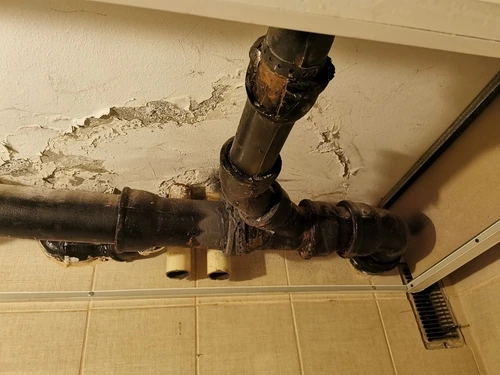
Cast iron was once the standard for drain and waste systems in older Canadian homes.
- Lifespan: Up to 100 years, though many are failing now.
- Strengths: Very durable, quiet water flow.
- Limitations: Heavy, prone to rust and clogging with time.
- Usage: Common in pre-1960s homes; many homeowners now choose lining or replacement.
Galvanized Steel Pipes
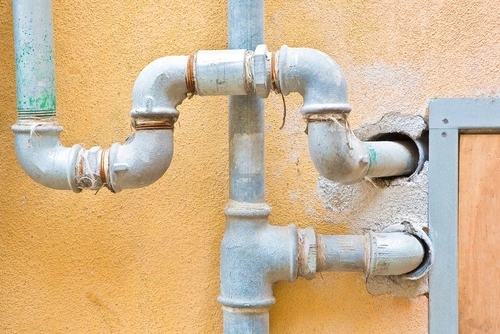
Galvanized pipes were widely used before the 1960s, but are now outdated.
- Lifespan: 40–50 years; often failed earlier.
- Strengths: Stronger than plastic; once seen as a reliable option.
- Limitations: Corrodes from the inside out, leading to low water pressure and discoloured water.
- Usage: No longer installed. If your home still has galvanized pipes, replacement is strongly recommended.
ABS, HDPE, and Stainless Steel
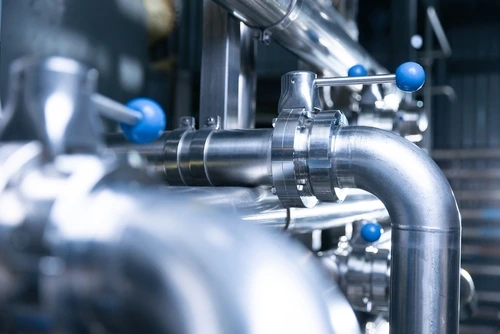
ADS, HDPE, and stainless steel pipes are less common in homes, but they may be used in specific applications.
- ABS: Black plastic; often used for drain, waste, and vent systems.
- HDPE: Flexible black plastic; ideal for underground water supply lines.
- Stainless steel: Corrosion-resistant metal; sometimes used in modern or coastal homes.
Why Canadian Winters Are Tough on Plumbing Pipe Types
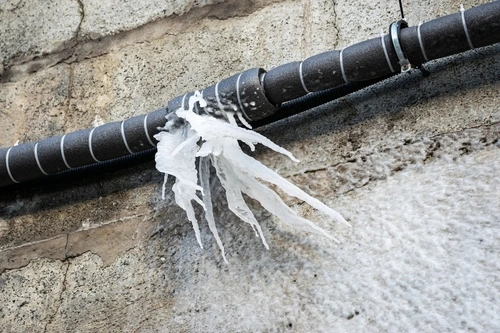
Plumbing materials don’t behave the same way in every climate. Long winters and deep frost lines can shorten pipe lifespans, increase the risk of bursts, and even determine which pipe materials are approved under building codes. Here are the main factors Canadian homeowners should keep in mind:
- Freeze and thaw cycles: Extreme cold can cause water inside pipes to freeze and expand. Materials like PEX are more flexible and freeze-resistant, while rigid materials such as copper or cast iron are more likely to burst without proper insulation.
- Soil shifting and frost lines: In colder provinces, underground pipes are buried deeper to sit below the frost line. Flexible materials like HDPE are better suited to handle shifting soils, whereas older cast iron or galvanized steel pipes can crack under pressure.
- Water quality: Canadian water sources vary widely in mineral content. Hard or acidic water can wear down copper pipes more quickly, while PVC and PEX are less affected.
- Building codes and standards: The Canadian Standards Association (CSA) approves specific materials for residential use. For example, once-common polybutylene piping is no longer acceptable due to its failure rate, while PEX and copper remain widely approved.
If you’re unsure whether your plumbing is ready for another winter, a professional inspection can give you peace of mind. A local Mr. Rooter Plumbing® service professional can check your system, insulate vulnerable pipes, and recommend upgrades to keep your home protected year-round.
Choosing the Right Pipe for the Job
No single plumbing material is perfect for every situation. The right choice depends on the pipe’s location, purpose, and resilience to changing temperatures. Here’s a comparison of the best plumbing pipe types for common applications:
| Application | Best Pipe Types | Why It Works |
|---|---|---|
| Indoor hot and cold water | Copper, PEX, CPVC | Copper is durable (50+ years); PEX is flexible and freeze-resistant; CPVC handles hot water affordably. |
| Drain, waste, and vent (DWV) | PVC, ABS, cast iron | PVC and ABS are lightweight and easy to install; cast iron is durable but mostly in older homes. |
| Underground water lines | HDPE, copper | HDPE flexes with shifting soil; copper provides long-lasting strength if buried below the frost line. |
| Retrofits and renovations | PEX | Flexible tubing makes installation easier in tight spaces and existing walls. |
| Older homes with legacy pipes | Pipe lining or replacement | Galvanized steel and aging cast iron often corrode or clog and should be relined or replaced. |
In colder provinces, CSA standards and the depth of the frost line determine the approved pipe types. PEX is often preferred because it resists bursting during freeze-thaw cycles. For older systems, modern solutions like pipe lining and relining can restore your plumbing without major excavation.
Even if a certain pipe material seems like the right fit, don’t discount the importance of quality installation and compliance with local building codes. A plumbing professional can help you choose the most appropriate and cost-effective option for your home.
When to Replace Pipes: Signs Homeowners Should Watch For
Pipes don’t usually fail overnight. They often give off warning signs first, but many of these indicators are easy to miss until a minor issue turns into costly water damage. Here’s what to watch for:
- Rust-coloured water: Brown or yellow water from the tap often signals corrosion in cast iron or galvanized steel pipes.
- Frequent leaks: One leak may be patchable, but repeated leaks typically indicate that the pipe walls are failing.
- Low water pressure: Rust and mineral buildup restrict flow, especially in galvanized steel or cast iron pipes.
- Unpleasant taste or odour: Metallic-tasting or foul-smelling water may point to corroded or contaminated lines.
- Winter damage: Frozen pipes that have burst once will often continue to fail if not upgraded — a common risk in Canadian winters.
- Visible corrosion: Green or blue stains on copper, or rust and flaking on steel, are early signs of breakdown.

If you’ve spotted any of these issues, don’t wait. Call your local Mr. Rooter team for an expert inspection, pipe leak repair and replacement, pipe lining and relining, or frozen pipe repair before small problems become emergencies.
Why Call Mr. Rooter Plumbing?
Your plumbing system works quietly behind the walls … until it doesn’t. From frozen copper lines in January to degraded galvanized steel pipes in older homes, small problems can quickly turn into big headaches if left unchecked. That’s where Mr. Rooter comes in.
Your local Mr. Rooter service professionals are ready to assist with inspections, repairs, and replacements — all backed by our Neighbourly Done Right Promise® to ensure your satisfaction.
Schedule a home pipe inspection from your local Mr. Rooter Plumbing team today and enjoy peace of mind for many winters to come.

This article is intended for general guidance only and is not applicable to every situation. You are responsible for determining the proper course of action for your property and situation. Mr. Rooter is not responsible for any damages that occur as a result of advice and/or guidance derived from its blog content. Some Mr. Rooter services vary by location. Contact your local Mr. Rooter franchise for more information.
FAQs About Plumbing Pipe Types
Mr. Rooter Plumbing is a one-stop solution for all your plumbing service needs. Whether you need a pipe repaired, clogs cleared, or drains cleaned, you can count on our experienced team to get the job done right! Our commitment to exceptional service includes answering your questions. Here are answers to some of your most frequently asked questions about plumbing pipe types.
What are the most common plumbing pipe types in Canadian homes?
The most common plumbing pipe types in Canadian homes are copper, PEX, PVC, CPVC, cast iron, and galvanized steel.
Newer houses typically use PEX or copper, while older properties may still have cast iron or galvanized steel pipes. Each material has a different expected lifespan and acceptable use.
How can I tell what kind of pipes I have in my home?
A visual inspection of piping underneath sinks and in the basement can usually tell you what type(s) of piping you have:
- Copper pipes are rigid and reddish-brown.
- PEX is flexible plastic in red, blue, or white.
- PVC is white or grey and often used for drains.
- Cast iron is heavy and dark.
- Galvanized steel is dull grey with threaded ends.
If you’re unsure, a professional inspection can confirm.
How long do plumbing pipes last in Canada?
Pipe lifespan depends on the material: Copper pipes last 50+ years, PEX and PVC 25–40 years, cast iron up to 100 years, and galvanized steel 40–50 years.
Harsh winters, frost lines, and water chemistry can all contribute to shortening these lifespans. Regular inspections help prevent costly issues.
Which pipes are best for Canadian winters?
PEX plumbing is generally considered the best option for Canadian winters because it resists freezing and bursting. Copper pipes are durable but can split if water freezes inside them.
PVC pipes are commonly used for drains, but are not recommended for supply lines.
When should I replace plumbing pipes?
Replace plumbing pipes if you notice rusty or discoloured water, recurring leaks, low water pressure, foul odours, or frequent freezing in winter.
Homes built before the 1960s may still contain cast iron or galvanized pipes, which should be inspected and updated. Explore pipe lining and relining services for long-term solutions.
Can old pipes be repaired instead of replaced?
Depending on their condition, pipes can sometimes be relined or patched. However, widespread corrosion, leaks, or freeze damage often mean full replacement is more cost-effective.
A Mr. Rooter Plumbing professional can recommend whether repair or replacement is best for your system.
Is PVC safe for drinking water in Canada?
PVC pipes are generally used for drains and vent lines, not the drinking water supply.
For potable water, Canadian homes rely on copper, PEX, or CPVC, all of which meet CSA standards. If you’d like a deeper look at the best supply line options, read our guide to water pipes in Canadian homes.
If you’re uncertain about the state of your water supply lines, consult a qualified plumber for safe replacement options.
Do Canadian building codes limit which pipe types can be used?
Yes. The Canadian Standards Association (CSA) approves specific pipe materials for residential use. Copper, PEX, PVC, and CPVC are all permitted under most provincial codes.
Outdated materials, such as polybutylene, are no longer accepted due to their failure risks. A local plumber can confirm code-compliant options for your home.

